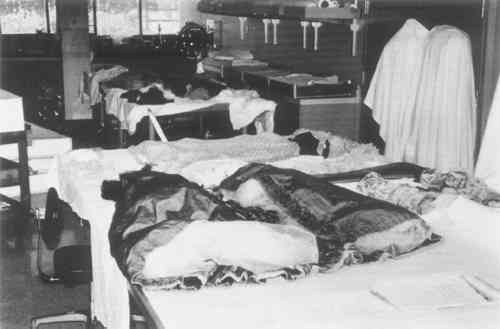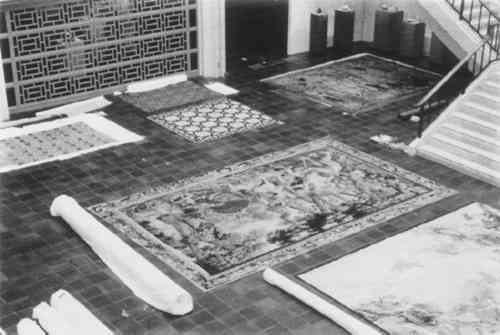RESCUING WATER-DAMAGED TEXTILES DURING THE LOS ANGELES RIOTSDUBRAVKA TURKOVIC-KISELJEV
5 EXAMPLES OF TREATMENTS5.1 COSTUMESBefore the riots, many of the costumes in the study collection were stored off site in closed, waterproof wooden crates. In preparation for storage, each costume had been padded with acid-free tissue and then placed in a muslin garment bag, suspended horizontally in a Fome-cor box. Each box was custom made in the museum to fit snugly in the crate. Unfortunately, at the time of the riots, some costumes were in cardboard boxes awaiting placement in wooden crates. These textiles suffered the most damage. Costumes that were stored in tightly sealed wooden crates sustained no damage. The costumes in need of urgent attention arrived first. Eight costumes were found in a collapsed cardboard storage box on the wet floor. Water had leaked from the ceiling onto the box. The box had split wide open, creating an urgent situation. The wet costumes were brought to the museum, and the goal was to avoid permanent staining and tide lines. The costumes were spread out in the textile conservation laboratory, quickly examined with brief written reports, and photographed. The wet costumes that showed no evidence of dye bleeding and appeared to have stable fibers and trims were washed in Orvus detergent and water. All of the costumes were padded out with nylon tulle to facilitate air-drying, and fans were used to speed the process. Overall, the costumes dried successfully, except for two: one with gelatin sequins that were softened or dissolved by the water and another that had a fugitive blue dye bleed into the pink silk of the dress and onto the neighboring costume. Neither costume was washed. This work, along with work on the tapestries, was completed in one day. To say the least, it was a stressful and exhausting experience. The next day, 25 American designer suits from the 1930s and 1940s and 4 early Californian (19th-century) dresses were brought to the museum. After examination, all were found to be slightly damp, and they were hung on hangers on portable racks in the atrium to dry. Finally, after the crated costumes and textiles were examined, three wooden crates of costumes were brought to the museum for examination. Apparently, one of the crates had not been closed tightly, and water had seeped in. The Fome-cor boxes were very wet, but the objects, stored in muslin bags, were only damp. All of the costumes were laid out in the costume and textile exhibition galleries and the textile and paper conservation laboratories to air-dry (fig. 2). As one side dried, the costumes were then turned over to dry on the other side. Similar to the very wet costumes, the damp ones were stuffed with nylon tulle and air-dried overnight. Since the damp costumes were in the crate for only a few days before it was opened, they had not become moldy and did not suffer any permanent damage.
5.2 TAPESTRIESBefore the riots, tapestries in the off-site storage had been rolled on a protected cardboard tube, covered with muslin, and wrapped in a layer of polyethylene. They were placed on custom-built storage racks that included a horizontally suspended steel pole placed through the cardboard tube. The polyethylene sheet was taped tightly around the ends where it met the steel pole. To facilitate thorough examination of the tapestries after the sprinklers were shut off and to remove them from the humid environment of the off-site storage area, all of the tapestries were brought to the museum, where a work area was established in a large open atrium. In an everyday situation, if one plans to work with tapestries on the floor, one would first cover the After the tapestries arrived, their outer polyethylene covers were removed, and they were divided into two categories: damp and dry. Fortunately, most fell into the dry category. The damp tapestries were unrolled face-up onto the floor in a large open space in the museum's atrium (fig. 3), and selective photography of damp areas was completed. The tapestries were allowed to air-dry. After examination confirmed that drying was complete, the tapestries were rerolled so that they could be moved to another gallery. Those tapestries that felt dry to the touch seemed to be in no direct danger. There was some uncertainty about how much dampness or high humidity might have affected these seemingly dry textiles. For the moment, though, since there was so much to do, these tapestries were assigned a lower priority. The outer coverings of muslin were opened, and the ends of the rolling tubes were propped up on blocks. Two weeks later, all of the tapestries were dry and showed no evidence of damage. They were covered with new polyethylene covers and returned to the off-site storage.
|

